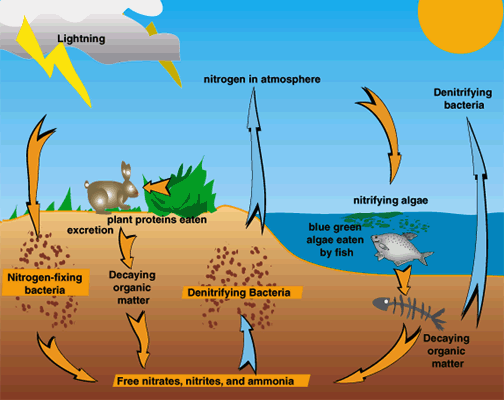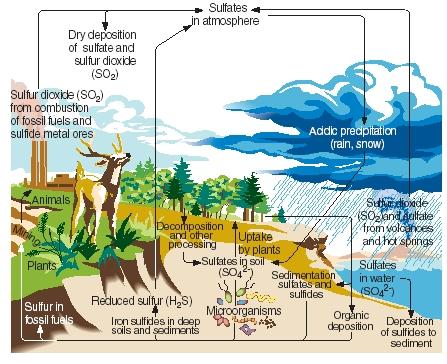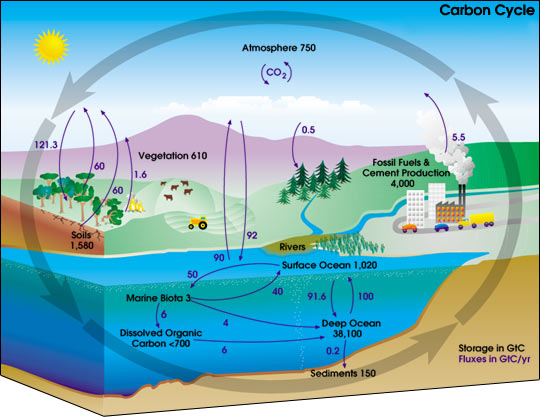

“All living organisms are related by common ancestry. All forms of life have emerged from that ancestry by a continuous process of variation throughout billions of years of geological history.”
“This wisdom of nature is the essence of ecoliteracy.”
“Based on the understanding of ecosystems as autopoietic networks and dissipative structures, we can formulate a set of principles of organization that may be identified as the basic principles of ecology and use them as guidelines to build sustainable human communities.”
“The first of these principles is interdependence.”
“ Understanding ecological interdependence means understanding relationships. ”
“The fact that the basic pattern of life is a network pattern means that the relationships among the members of an ecological community are nonlinear, involving multiple feed back loops.”

‘The cyclical nature of ecological processes is an important principle of ecology.”



The Nitrogen cycle and the Sulfur cycle are needed, cooperant subunits of carbon cycles.
1970, Humberto Maturana, Chilean neuroscientist, asked "What takes place in the phenomenon of perception?"
"What then was Maturana's central insight?"
"My investigations of color perception led me to a discovery that was extraordinarily important to me: The nervous system operates as a closed network of interactions, in which every change of the interactive relations between certain components always results in a change of the interactive relations of the same or of other components."
"From this discovery Maturana drew two conclusions, which gave him answers to his two major questions. He hypothesized that the 'circular organization' of the nervous system is the basic organization of living systems: 'Living systems . . . are] organized in a closed causal circular process that allows for evolutionary change in the way the circularity is maintained, but not for the loss of the circularity itself."
"He postulated that the nervous system is not only self-organizing but also continually self-referring, so that perception cannot be viewed as a representation of an external reality but must be understood as the continual creation of new relationships within the neural network: 'The activities of nerve cells do not reflect an environment independent of the living organism and hence do not allow for the construction of an absolutely existing external world".
"no forces or principles will be adduced which are not found in the physical universe."
"Yet, our problem . . . will not be in properties of components, but in processes and relations between processes realized through components."
"When Maturana and Varela describe the pattern of life as an autopoietic network, the main emphasis is on the organizational closure of the pattern. When Ilya Prigogine describes the structure of a living system as a dissipative structure, by contrast, his main emphasis is on the openness of that structure to the flow of energy and matter. Thus a living system is both open and closed – it is structurally open, but organizationally closed. Matter continually flows through it, but the system maintains a stable form, and it does so autonomously through self-organization."
"To highlight that seemingly paradoxical coexistence of change and stability, Prigogine coined the term 'dissipative structures.' . . .[but] not all dissipative structures are living systems, . . . . "
“Ecosystems differ from individual organisms in that they are largely closed systems with respect to the flow of matter, while being open with respect to the flow of energy.”
“Solar energy in its many forms–. . . is the only kind of energy that is renewable, economically efficient, and environmentally benign.”
“The principles of ecology mentioned so far–interdependence, the cyclical flow of resources, cooperation, and partnership–are all different aspects of the same pattern of organization. This is how ecosystems organize themselves to maximize sustainability.”
 Energy flows from the bacterial and plant level of "producers" through all other parts of an ecological system because plants and bacteria convert thermal and radiative energy from the Earth and Sun respectively into matter, this living matter is called biomass.
Energy flows from the bacterial and plant level of "producers" through all other parts of an ecological system because plants and bacteria convert thermal and radiative energy from the Earth and Sun respectively into matter, this living matter is called biomass.
“two further principles of ecology–flexibility and diversity–that enable ecosystems to survive disturbances and adapt to changing conditions.”
“All ecological fluctuations take place between tolerance limits. There is always the danger that the whole system will collapse when fluctuation goes beyond those limits and the system can no longer compensate for it.”
“Temporary stress is an essential aspect of life, but prolonged stress is harmful and destructive to the system. These considerations lead us to the important realization that managing a social system . . . means finding the optimal values for the system’s variables. If one tries to maximize any single variable instead of optimizing it, this will invariably lead to the destruction of the system as a whole.”
Forests are tangible examples of how an "ecosystems' . . . diversity" is so "closely connected with the system’s network structure" –move the mouse over the photograph.
“In ecosystems the role of diversity is closely connected with the system’s network structure. A diverse ecosystem will also be resilient because it contains many species with overlapping ecological functions that can partially replace one another.”
“Diversity means many different relationships, many different approaches to the same problem . . . . Capable of adapting to changing situations.”
“However diversity is of strategic advantage only if there is a truly vibrant community, sustained by a web of relationships.”
System - is any set of recognizably related components and their exposed and hidden relations that function together such that the combined impacts of these working pieces is greater than the mere sum of the operating parts. See: systemic thinking.
 The twin gears that mesh are a simple system.
The twin gears that mesh are a simple system.
autopoiesis from poiesis ; In the Symposium (a Socratic dialogue written by Plato), Diotima describes how mortals strive for immortality in relation to poieses. In all begetting and bringing forth upon the beautiful there is a kind of making / creating or poiesis. In this genesis there is a movement beyond the temporal cycle of birth and decay.
"Such a movement can occur in three kinds of poiesis:
(1) Natural poiesis through sexual procreation,
(2) poiesis in the city through the attainment of heroic fame and finally, and
(3) poiesis in the soul through the cultivation of virtue and knowledge."[1]
Thus autopoiesis means self creating, self generating, or functionally self-sustaining.
 Fritjof Capra, The Web of Life. New York: Anchor Books, 1996.
Fritjof Capra, The Web of Life. New York: Anchor Books, 1996.
Solving ecological problems